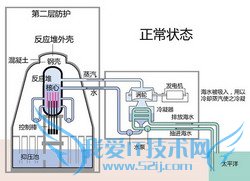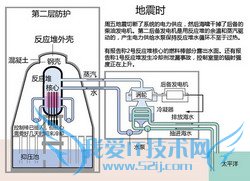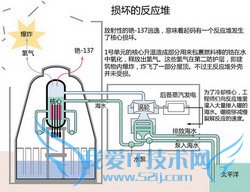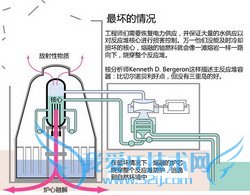欢迎您访问52ij英汉互译网,今天小编为你分享的英语知识是:【图解福岛核电站事故:核反应堆失灵有何危险】,下面是详细的分享!
图解福岛核电站事故:核反应堆失灵有何危险
日本地震引发的核泄漏危机使得人心惶惶,网上各种瞎扯的消息铺天盖地,与其在假消息中挣扎,倒不如来普及一下科学知识。核反应堆究竟是什么东西?它的工作原理是怎样的?今天我们就来图解福岛核电站故障。
核反应堆相关词汇表:
core 核心
control rods 控制棒
reactor vessel 反应堆
suppression pool 抑压池
primary containment vessel 第一层安全壳(反应堆外壳)
secondary containment building 第二层安全壳
turbine 涡轮
condenser 冷凝器
backup steam generator 备用蒸汽发电机


正常状态 地震时


尝试冷却反应堆 最坏情况
点击图片查看相应内容哦!
(本文图片来源:煎蛋)

Normal operation正常状态
In operation since the early 1970s, Japan's Fukushima Daiichi nuclear plant uses six boiling water reactors, which rely on uranium nuclear fission to generate heat. Water surrounding the core boils into steam that drives turbines to generate electricity.从19世纪70年代投入运行以来,日本福岛第一核电站利用六个沸水堆,通过铀核裂变来产生热能。核心周围的水沸腾后变成水蒸气,推动涡轮从而发电。
The reactor vessel is surrounded by a thick steel-and-concrete primary containment vessel, equipped with a water reservoir designed to suppress overheating of the vessel.反应堆由一个钢与混凝土构成的厚实外壳(第一层安全壳)保护着,另外还配有一个蓄水库,防止反应堆过热。
The suppression pool is designed to protect the primary vessel if the core gets too hot. Valves release steam into the pool, where it condenses, relieving dangerous pressure.当核心过热时,抑压池可以起到保护第一层安全壳的作用。这时阀门会打开,水蒸气就能进入抑压池内冷凝,减缓压力过大造成的危险。
- 评论列表(网友评论仅供网友表达个人看法,并不表明本站同意其观点或证实其描述)
-
